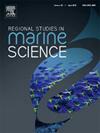孟加拉湾海水密度剖面和硝酸盐生产力的时空变异
IF 2.4
4区 环境科学与生态学
Q3 ECOLOGY
引用次数: 0
摘要
孟加拉湾(BoB)是一个动态的海洋环境,由复杂的海洋学过程和大量的淡水流入形成。尽管海水密度变化在驱动营养物动态方面发挥着关键作用,但人们对海水密度剖面与海水硝酸盐生产力之间的时空相互作用了解有限。本研究旨在了解海水密度变化、硝态氮(NO3)生产力及其时空动态关系。利用2004 - 2023年的遥感数据,分析了海表温度(SST)、海表盐度(SSS)、混合层深度(MLD)和密度的变化,揭示了这些因素如何影响初级生产力。分析表明,海温在5月达到峰值,温度达到30.5 °C,而NO3生产力高,特别是沿海地区,出现在8月和9月,浓度最高,达到80.32 mg/L。相比之下,西南海域的开放海域在同一时期表现出较高的NO3密度(约为22.0 kg/m³)和相对较低的NO3生产力。EOF分析确定了主要的空间模式,第一个主成分解释了76% %的方差,捕获了密度和硝酸盐生产力的季节性波动。相关分析显示,sigma-t与硝酸盐呈负相关(-90 %),而盐度与密度呈正相关(91 %),证实了密度对养分有效性的调节作用。此外,观测到MLD在4月最浅(~ 20 m),在7月最深(约90 m),这显著影响了垂直养分混合的有效性和生产力。该研究为海水密度波动如何影响硝酸盐有效性和初级生产力提供了新的见解,有助于改进生物地球化学建模和可持续海洋资源管理。研究结果强调了淡水排放和季风周期对北极生态系统的重大影响,并强调了遥感对监测和管理海洋资源的重要性,以支持应对气候变化的可持续管理实践。本文章由计算机程序翻译,如有差异,请以英文原文为准。
Spatiotemporal variability of seawater density profile and nitrate productivity in the Bay of Bengal
The Bay of Bengal (BoB) is a dynamic marine environment shaped by complex oceanographic processes and significant freshwater influxes. Despite the critical role of seawater density variations in driving nutrient dynamics, there is limited understanding of the spatiotemporal interplay between seawater density profiles and nitrate productivity in the BoB. This study aimed to understand the relationship between seawater density variations, nitrate (NO3) productivity, and their spatiotemporal dynamics in the BoB. Remote sensing data from 2004 to 2023 were utilized to analyze sea surface temperature (SST), sea surface salinity (SSS), mixed layer depth (MLD), and density variations, providing insights into how these factors influence primary productivity. The analysis revealed that SST peaks in May, with temperatures reaching 30.5 °C, while high NO3 productivity, especially in coastal regions, occurs during August and September, with the highest concentration recorded at 80.32 mg/L. In contrast, the open ocean areas in the southwestern BoB exhibit higher densities (approximately 22.0 kg/m³) and comparatively lower NO3 productivity during the same period. EOF analysis identifies dominant spatial patterns, with the first principal component explaining 76 % of the variance, capturing seasonal fluctuations in density and nitrate productivity. Correlation analysis reveals a strong negative correlation (-90 %) between sigma-t and nitrate, while salinity and density show a positive correlation (91 %), confirming the role of density in regulating nutrient availability. Additionally, the MLD was observed to be shallowest in April (∼20 m) and deepest in July (approximately 90 m), significantly influencing availability of vertical nutrient mixing and productivity. This study provides new insights into how seawater density fluctuations influence nitrate availability and primary productivity, contributing to improved biogeochemical modeling and sustainable marine resource management in the BOB. The findings highlight the significant influence of freshwater discharge and monsoonal cycles on the BoB's ecosystem and emphasize the importance of remote sensing for monitoring and managing marine resources to support sustainable management practices in response to climate variability.
求助全文
通过发布文献求助,成功后即可免费获取论文全文。
去求助
来源期刊

Regional Studies in Marine Science
Agricultural and Biological Sciences-Ecology, Evolution, Behavior and Systematics
CiteScore
3.90
自引率
4.80%
发文量
336
审稿时长
69 days
期刊介绍:
REGIONAL STUDIES IN MARINE SCIENCE will publish scientifically sound papers on regional aspects of maritime and marine resources in estuaries, coastal zones, continental shelf, the seas and oceans.
 求助内容:
求助内容: 应助结果提醒方式:
应助结果提醒方式:


